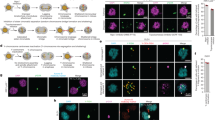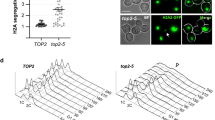Abstract
THE mechanisms involved in chromosome rejoining are not understood. We showed that chromosome rejoining in Robertsonian centric fusion can be studied cytologically1 with a staining technique based on the quenching by 5-bromodeoxyuridine (BrdU) of the fluorescence of the dye 33258 Hoechst2. When mouse cells were grown for one generation in the presence of BrdU and stained with 33258 Hoechst, there was a brightly fluorescent spot appearing over half of the centromeric region in every autosome3. (This asymmetry presumably reflects the unequal distribution of thymidine (45% compared with 22%) between the two chains of mouse satellite DNA4, the fluorescent spot representing the old thymidine-rich chain of satellite DNA.) The arrangement of fluorescent spots in metacentric chromosomes resulting from Robertsonian fusion suggested that the thymidine-rich chain of satellite DNA in the centromeric region is associated with the same DNA chain (in terms of polarity) in every mouse autosome1. We have used the centromeric asymmetry in mouse chromosomes as a marker for DNA polarity in studies on radiation and drug-induced chromosomal translocation and sister chromatid exchange (SCE).
This is a preview of subscription content, access via your institution
Access options
Subscribe to this journal
Receive 51 print issues and online access
$199.00 per year
only $3.90 per issue
Buy this article
- Purchase on Springer Link
- Instant access to full article PDF
Prices may be subject to local taxes which are calculated during checkout
Similar content being viewed by others
References
Lin, M. S., and Davidson, R. L., Science, 185, 1179–1181 (1974).
Latt, S. A., Proc. natn. Acad. Sci. U.S.A., 70, 3395–3399 (1973).
Lin, M. S., Latt, S. A., and Davidson, R. L., Expl Cell Res., 86, 392–395 (1974).
Flamm, W. G., McCallum, M., and Walker, P. M. B., Proc. natn. Acad. Sci. U.S.A., 57, 1729–1734 (1967).
Brewen, J. G., and Peacock, W. J., Proc. natn. Acad. Sci. U.S.A., 62, 389–394 (1969).
Latt, S. A., Davidson, R. L., Lin, M. S., and Gerald, P. S., Expl Cell Res., 87, 425–429 (1974).
Marin, G., and Prescott, D. M., J. Cell Biol., 21, 159–167 (1964).
Gatti, M., and Olivieri, G., Mutation Res., 17, 101–112 (1973).
Latt, S. A., Proc. natn. Acad. Sci. U.S.A., 71, 3162–3166 (1974).
Taylor, J. H., Genetics, 43, 515–529 (1958).
Author information
Authors and Affiliations
Additional information
Reprint requests to: Dr. Richard L. Davidson, Children's Hospital Medical Center, 300 Longwood Avenue, Boston, Massachusetts 02115.
Rights and permissions
About this article
Cite this article
LIN, M., DAVIDSON, R. Centromeric asymmetry and induction of translocations and sister chromatid exchanges in mouse chromosomes. Nature 254, 354–356 (1975). https://doi.org/10.1038/254354a0
Received:
Revised:
Issue Date:
DOI: https://doi.org/10.1038/254354a0
This article is cited by
Comments
By submitting a comment you agree to abide by our Terms and Community Guidelines. If you find something abusive or that does not comply with our terms or guidelines please flag it as inappropriate.



